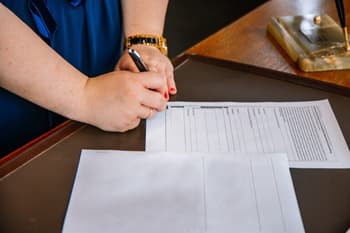In certain circumstances, you can apply for trade mark protection for shapes, colours and fonts. However, it is more difficult than protecting a word mark or a logo, and you must meet more specific criteria. As such, trade marking shapes, colours and fonts can be a highly complex process. This article will explain the processes and possible difficulties involved in applying for a shape, colour or font trade mark.

This guide explains the essentials of trade marks and the steps required to register a trade mark.
What Is a Shape Trade Mark?
If an object’s three-dimensional configuration is distinctive enough to identify a brand, it may be regarded as a shape trade mark. This distinctiveness must be a non-functional “added extra” that contributes to brand identity and is essential for commercial success. A classic example is Coca-Cola’s bottle, and other examples include chocolate biscuits (like Tim Tams), highlighters, or even a hairbrush.
However, navigating the complexities of registering a trade mark with an irregular shape requires expertise. Seeking advice from a trade mark lawyer is highly advisable to ensure a smooth and successful registration process. This will help safeguard your brand’s identity and exclusivity in the market. Trade mark lawyers can also assist in protecting your unique product shape from potential infringement or disputes.
What Should I Have in Mind When Applying for a Shape Trade Mark?
When the trade mark examiner assesses your application, they consider the commonality of the shape you seek to register. Is it a shape that, if the trade mark is registered, would unfairly limit others in their use of this shape? For example, a perfect sphere might not be suitable for trade mark registration as it is not unique, especially for goods that are often spherical, like marbles or chocolates.
A great question is whether the shape is essential to the product’s functionality. Wine bottles are a good example of a shape that cannot be protected because of their utility value.
If the shape you are attempting to protect is not enough of an identifier of your product, there could be problems differentiating it and registering it. You must prove that this particular shape uniquely identifies your goods or services. To know if your unique shape is eligible for trade mark registration, speak with a trade mark lawyer so that they can help review your application.
Continue reading this article below the formWhat Must I Prove to Register a Colour or Combination of Colours?
Gaining trade mark protection for a specific colour could be challenging. Nevertheless, it is not entirely impossible. To proceed, we recommend contacting a trade mark specialist.
However, before you begin the process, some critical factors must be considered to determine whether a particular colour is eligible for trade mark protection. These factors are listed below.
Distinctiveness
Like any trade mark, the colour or colour combination must be inherently distinctive or have acquired distinctiveness through extensive use with specific goods or services. It must uniquely identify and distinguish the source of the goods or services.
Secondary Meaning
If the colour is not inherently distinctive, evidence that consumers exclusively associate it with your brand due to long-term use and marketing efforts (also known as secondary meaning) will be required.
Goods and Services
The colour should be used in commerce consistently and exclusively to identify your goods or services. It should not be functional or essential to the product or service itself. Depending on what category of goods or services your application falls into, there must be no need for that particular colour in that industry.
Ask yourself, what are the typical colours used in your industry? Are the colours you are applying to have protection for shades of these standard colours?
In simple terms, the colour should not be essential to the utility or functionality of the product in question. Is the colour something that all competitors must retain the right to use? One example might be the use of yellow for warning symbols. Unless your application falls outside these exclusions, securing colour trade mark protection will be challenging. Similar to the requirements for shape trade marks, you must demonstrate that this colour is a distinctive identifier of your product. A notable example of a successful application is the colour orange for Veuve Clicquot champagne:
Description and Representation
To precisely identify the claimed colour, describe the colour or colour combination. Accompany it with accurate visual representations, such as Pantone colour codes or other standard colour references.
Specific Use
To further prove that this colour is distinctively yours, you must show evidence proving your continued use of the colour. You must show how this colour forms part of your reputation.
Are There Limitations on the Types of Font I Can Use With My Trade Mark?
Your trade mark protection may extend to other fonts if your registration was in a regular or cursive font, though this is not guaranteed. If you use a distinctive font, your registration might not cover expressions of the exact words in a different font or style.
In general, though, fonts cannot be registered as trade marks (although the names of fonts can be). The protection given to a trade mark of a name or slogan in a distinctive style is really for that specific display of words in that particular style. As with other trade marks, infringement is a matter of degree.
Key Takeaways
Registering a trade mark for shapes, colours, or fonts is possible but challenging. You must prove that your mark is distinctive and does not serve a functional purpose. Consulting a trade mark lawyer can help you navigate the complexities and strengthen your application, ensuring your brand’s identity is well-protected.
If you need help, our experienced IP lawyers can assist as part of our LegalVision membership. You will have unlimited access to lawyers to answer your questions and draft and review your documents for a low monthly fee. Call us today on 1300 544 755 or visit our membership page.
Frequently Asked Questions
Can I trade mark a shape?
Yes, but only if the shape is distinctive enough to identify your brand and is not essential for the product’s function. Examples include Coca-Cola’s bottle and uniquely shaped chocolate biscuits like Tim Tams.
Can I trade mark a colour?
Yes, but it is difficult. You must prove that consumers associate the colour with your brand through long-term use and marketing. The colour must not be functional or commonly used in your industry.
We appreciate your feedback – your submission has been successfully received.











